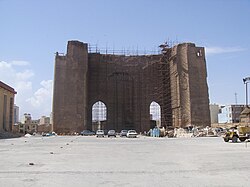Arg-e-Tabriz
| Arg-e-Tabriz | ||
|---|---|---|
 Arg-e-Tabriz during restoration |
||
| Data | ||
| place | Tabriz , Iran | |
| architect | Falaki Tabrisi | |
| Client | Taj od-Din Alishah | |
| Architectural style | Azari | |
| height | 28 m | |
| Coordinates | 38 ° 4 '20.6 " N , 46 ° 17' 18" E | |
|
|
||
Arg-e-Tabriz ( Persian ارگ تبریز Arg-e-Tabris , IPA : [ æɾg ɛ tæbɾiz ]) are historical remains of a mosque in the Iranian city of Tabriz . Arg-e-Tabriz is one of the tallest historical walls in Iran and are a symbol of the city. The wall is located in the city center on the south side of the junction of Imam Khomeini Street and Ferdossi Street.
history
The mosque was started in the Ilkhan era under the supervision of Minister Taj od-Din Alishah. After the death of the minister and the collapse of the roof, construction was interrupted. Arg-e-Tabriz was later used as an educational center during the Safavid era . Destruction followed during the Ottoman occupation . In the Qajar era during the Russo-Persian War , the building served as a warehouse and warehouse for the Iranian army . After the Islamic Revolution , a large part of the wall was leveled and blown up in 1981 to make way for a new Friday mosque .
Currently only part of the huge wall and mihrab of the southern Shabestan is standing . The remains of the wall are about 28 m high. The last restorations took place in 2013 at the instigation of the Organization for Cultural Heritage, Crafts and Tourism .
Web links
Individual evidence
- ↑ Mohammad Karim Pirnia: The style of the Iranian architecture . Ed .: Gholamhosseyn Memarian. Sorush-e-Danesh, 2007, ISBN 964-96113-2-0 , p. 204 (Persian: Sabkschenāssi ye Memāri e Irāni .).
- ↑ http://www.farsnews.com/newstext.php?nn=13920230000413
